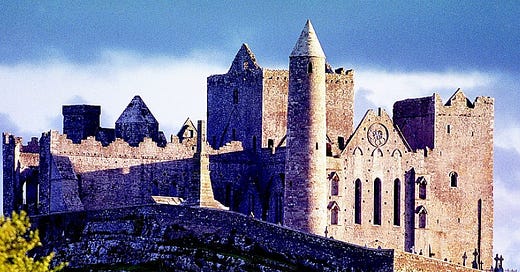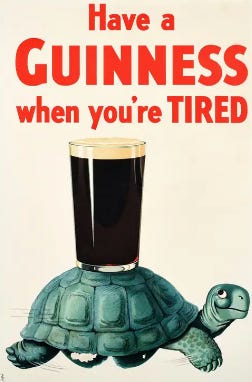The peculiar tale of the black beer that saved lives
And the man who turned a $54 investment into a $2.2 billion fortune
He didn’t come from a wealthy family. And you could say he was a “church-going man.”
In fact his godfather was the Archbishop of Cashel, which is located in the small Irish village of Celbridge.
He lived at a time when no one really understood how diseases were spread.
And they particularly didn’t understand how certain types of micro-organisms could easily contaminate public drinking water.
We’re talking micro-organisms that cause disease such as cholera, diarrhea, dysentery, hepatitis A, typhoid, and polio.
And we’re talking back in the late 1800’s, when people drank from the same water in which they dumped their garbage and sewage.
People were dying from drinking the water.
However due to his faith and always wanting to do well, he came up with an idea that would change everything.
The Gin Graze
Born in 1725 in Celbridge, Ireland, Arthur Guinness grew up in a family that worked as groundskeepers for Arthur Price, who was the Archbishop of Cashel.
The Archbishop was one of those kinds of people who didn’t want to burden himself with a daily routine, so he hired Arthur to serve as his manager for all cases that came before him.
It was a good job for Arthur … one that helped provide for his family of 10 children. (He actually had 21 children with his wife Olivia, but only 10 lived to adulthood.)
When the Archbishop wasn’t giving Sunday sermons, he’d be in the basement of his house brewing beer. It was his hobby and something he showed Arthur Guinness how to do as well. But Arthur only did it in his spare time.
As you might imagine, the Archbishop and Arthur grew quite close over time. The Archbishop even baptized Arthur’s oldest son, Arthur Guinness the second.
When Arthur Price died in 1752, he left a legacy of 100 pounds to Arthur Guinness. At the time that was considered quite a large sum of money. It certainly was enough for him and his family to live a good life.
After the Archbishop passed away, Arthur had more time on his hands. So he decided why not make use of all the brewing equipment that was now left at his disposal.
So he began brewing ale and selling it to the town folk.
But that would prove to be a bit of an uphill battle. That’s because once people stopped drinking the contaminated water, they turned to alcohol. And in particular, they drank gin. And lots of it.
Yet they couldn’t buy it on the open market because Parliament had enacted a law which forbid the importation of liquor. So the people of Ireland and Britain began making their own gin.
In fact they made so much that drunkenness became the rage.
Every sixth house in England was a “gin house.” And many advertised that they sold gin with slogans such as, “Drunk for one penny, dead drunk for two pence, clean straw for nothing.”
No matter how much gin people drank, Arthur Guinness wasn’t about to give up on brewing beer. Nope, he was going all in.
9,000 Bottles of Beer on the Wall
For ten years, Mark Rainsford's Ale Brewery had been on the market and yet not a single person had shown any interest in buying it. The brewery sat on four-acres of property with four buildings -- a living quarters, a horse stable, a malt house, and a brew house.
Everything you’d need to brew beer. However most of the buildings were pretty run down and needed to be renovated.
And the street where it was located already had a few small breweries, so there really was no reason to operate another one, especially one that was as dilapidated as Mark’s Ale House.
In truth the only thing that the brewery had that was worthwhile was it sat near a good supply of water.
Yet for Arthur Guinness this was the perfect place to start his own brewery. He’d no longer have to brew beer in the basement of the Archbishop’s house. And fixing the place up wasn’t an issue for him.
So he agreed to lease the brewery for around $54 a month. Yet there was one clause in the lease that he’d have to agree to … renting the property for a term of 9,000 years!
Arthur Guinness was sold. He signed the lease papers without hesitation. The next thing he did was change the name of the brewery to St. James’s Gate, which is named after both a neighborhood in Dublin and an actual medieval gate leading into the city.
Beers to Your Health
Now Arthur Guinness’ entrance into the world of brewing came with its share of competition. Throughout the city of Dublin there were about 70 small breweries at the time. But Arthur wasn’t worried about his competitors.
See he realized that the brew they made came with a harsh taste. That’s one of the other reasons the residents drank gin (and whiskey). Besides that, beer wasn’t really popular in the smaller towns scattered throughout Dublin.
But Arthur wasn’t going to make your average ordinary beer. Oh no, Dear Reader, he had a different brew in mind. He concentrated on making ale, where yeast is fermented at warmer temperatures., giving the beer refreshing taste.
People loved his brew. In fact it became one of the more popular drinks. But also the alcohol in the beer killed any bacteria in the water that was used in the brewing process.
This meant residents didn’t have to worry whether they’d get sick from the water. In fact in many ways, drinking beer saved their lives because it was an alternative to water.
But that’s not all. Beer had a lower alcohol content than whiskey and gin, which went a long way to curbing the rampant rage of alcoholism.
Brewing a Legacy
But in his heart of hearts, Arthur was an experimenter.
And he decided to turn his attention to making another kind of beer. This time he brewed a beer using roasted barley, which gave the beer a richer taste. And since the roasted barley produced a much darker color, it looked more like “black beer” than the typical “yellow-ish” beers folks were used to drinking.
Arthur sold his first batch of the new black beer in 1778. People absolutely loved it. Demand soared.
By 1779, Arthur was brewing more black beers (stout) and less ales. In fact Arthur’s black beer made the Guinness company one of most iconic symbols of Ireland.
However just four years later, at the age of 78, Arthur Guinness died.
But the business continued. In fact as a legacy to his children, he left them with $30,000 each. By today’s standards that would amount to over one million dollars.
After his death, the business was managed by three of his sons: Arthur II, Benjamin, and William. In fact the company was passed down from father to son for five consecutive generations.
Under Arthur II’s leadership, the company produced approximately 809,000 gallons of beer a year — impressive, but it was only the beginning.
He turned the St. James Gate Brewery into the largest brewery in Ireland. Annual sales were growing by at least 10%. And by the late 1830’s, the company was selling more than 4 million gallons of beer each year.
When Cecil Edward Guinness of the fourth generation took over running the company, he managed to turn it into the largest brewery in the world.
And in 1962, Benjamin Guinness of the fifth generation took over as Chairman. He was the last member of the Guinness family to hold this position until his death in 1986.
In 1997 Guinness merged with Grand Metropolitan Plc. A new company was formed called Diageo Plc. The name ‘DIAGEO’ is derived from the Latin word for ‘day’ and the Greek word for ‘world’ because every day, around the world, millions of people enjoy drinking a pint of Guinness beer.
Today, you can find a Guinness brewery the world over. In addition to its flagship location in Dublin, Ireland, Guinness is brewed in nearly 50 countries, with approximately 10 million glasses of the stout served each day.
Guinness has developed a keen following in countries as far as Nigeria, where there are more Guinness drinkers than in all of Ireland.
The company that Arthur started for just $54 is now valued at over $2 billion dollars.
Awesome Quotes by Awesome People
“May the winds of fortune sail you; may you sail a gentle sea; may it always be the other guy who says, “This drinks on me.”— Old Irish saying






